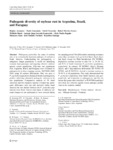Use este identificador para citar ou linkar para este item:
http://www.alice.cnptia.embrapa.br/alice/handle/doc/981729Registro completo de metadados
| Campo DC | Valor | Idioma |
|---|---|---|
| dc.contributor.author | AKAMATSU, H. | pt_BR |
| dc.contributor.author | YAMANAKA, N. | pt_BR |
| dc.contributor.author | YAMAOKA, Y. | pt_BR |
| dc.contributor.author | SOARES, R. M. | pt_BR |
| dc.contributor.author | MOREL, W. | pt_BR |
| dc.contributor.author | IVANCOVICH, A. J. G. | pt_BR |
| dc.contributor.author | BOGADO, A. N. | pt_BR |
| dc.contributor.author | KATO, M. | pt_BR |
| dc.contributor.author | YORINORI, J. T. | pt_BR |
| dc.contributor.author | SUENAGA, K. | pt_BR |
| dc.date.accessioned | 2014-03-06T11:11:11Z | pt_BR |
| dc.date.available | 2014-03-06T11:11:11Z | pt_BR |
| dc.date.created | 2014-03-06 | pt_BR |
| dc.date.issued | 2013 | pt_BR |
| dc.identifier.citation | Journal of General Plant Pathology, v. 79, n. 1, p. 28-40, Jan. 2013. | pt_BR |
| dc.identifier.issn | 1345-2630 | pt_BR |
| dc.identifier.uri | http://www.alice.cnptia.embrapa.br/alice/handle/doc/981729 | pt_BR |
| dc.description | Phakopsora pachyrhizi, the cause of soybean rust, is an economically important pathogen of soybean in South America. Understanding the pathogenicity of indigenous fungal populations is useful for identifying resistant plant genotypes and targeting effective cultivars against certain populations. Fifty-nine rust populations from Argentina, Brazil, and Paraguay were evaluated for pathogenicity in three cropping seasons, 2007/2008?2009/2010, using 16 soybean differentials. Only two pairs of P. pachyrhizi populations displayed identical pathogenicity profiles, indicating substantial pathogenic variation in the rust populations. Comparative analysis of 59 South American and five Japanese samples revealed that pathogenic differences were not only detected within South America but also distinct between the P. pachyrhizi populations from South America and Japan. In addition, seasonal changes in rust pathogenicity were detected during the sampling period. The differentials containing resistance genes (Rpp: resistance to P. p achyrhizi) Rpp1, Rpp2, Rpp3, and Rpp4, except for Plant Introduction (PI) 587880A, displayed a resistant reaction to only 1.8?14, 24?28, 22, and 36 % of South American P. pachyrhizi populations, respectively. In contrast, PI 587880A (Rpp1), Shiranui (Rpp5), and 3 Rpp-unknown differentials (PI 587855, PI 587905, and PI 594767A) showed a resistant reaction to 78?96 % of all populations. This study demonstrated that P. pachyrhizi populations from South America vary geographically and temporally in pathogenicity and that the known Rpp genes other than Rpp1 in PI 587880A and Rpp5 have been less effective against recent pathogen populations in the countries studied. | pt_BR |
| dc.language.iso | eng | eng |
| dc.rights | openAccess | eng |
| dc.title | Pathogenic diversity of soybean rust in Argentina, Brazil, and Paraguay. | pt_BR |
| dc.type | Artigo de periódico | pt_BR |
| dc.date.updated | 2014-04-09T11:11:11Z | pt_BR |
| dc.subject.thesagro | Soja | pt_BR |
| riaa.ainfo.id | 981729 | pt_BR |
| riaa.ainfo.lastupdate | 2014-04-09 | pt_BR |
| dc.identifier.doi | 10.1007/s10327-012-0421-7 | pt_BR |
| dc.contributor.institution | HAJIME AKAMATSU, JIRCAS; NAOKI YAMANAKA, JIRCAS; YUICHI YAMAOKA, Faculty of Life and Environmental Sciences, University of Tsukuba; RAFAEL MOREIRA SOARES, CNPSO; WILFRIDO MOREL, CICM/CRIA/IPTA; ANTONIO JUAN GERARDO IVANCOVICH, EEA-Pergamino/INTA; ALICIA NOELIA BOGADO, CICM/CRIA/IPTA; MASAYASU KATO, JIRCAS; JOSÉ TADASHI YORINORI, CNPSO; KAZUHIRO SUENAGA, JIRCAS. | pt_BR |
| Aparece nas coleções: | Artigo em periódico indexado (CNPSO)  | |
Arquivos associados a este item:
| Arquivo | Descrição | Tamanho | Formato | |
|---|---|---|---|---|
| PathogenicdiversityofsoybeanrustinArgentinaBrazil.pdf | 659,75 kB | Adobe PDF |  Visualizar/Abrir |









